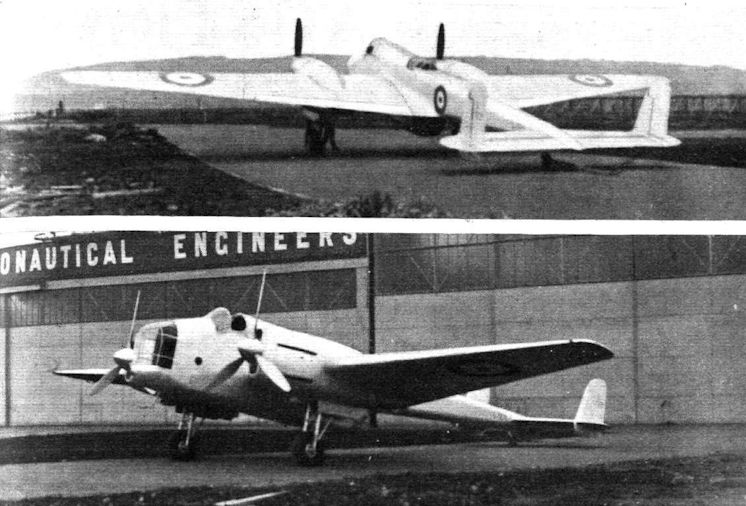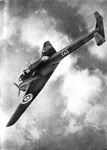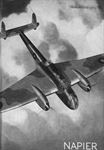
Описание
Страна : Великобритания
Год : 1937
Средний бомбардировщик с экипажем из четырех человек
Варианты
- Handley Page - Hampden / H.P.52 - 1936 - Великобритания
- Handley Page - Hereford / H.P.53 - 1937 - Великобритания
Hereford / H.P.53
Средний бомбардировщик, двухмоторный цельнометаллический моноплан с двухкилевым оперением, убирающимся шасси с хвостовым колесом. Экипаж 4 - 5 человек. Спроектирован в КБ фирмы "Хэндли-Пейдж" под руководством Г.Лачманна. Первый полет совершил 21 июня 1936 г. Серийное производство начато в июне 1938 г. Выпускался заводами "Хэндли-Пейдж" (Криклвуд), "Шорт энд Гарланд" (Белфаст), "Инглиш электрик" (Сэмлсбюри), "Кэнедиэн асошиэйтед эйркрафт" (Мэлтон, Сент-Губерт). Всего построено 1580 экз.
Вооружение первых серий 4x7,69, последующих - 6x7,69; многие самолеты доработаны в частях в вариант 8x7,69. Бомбы до 1250 кг.
Самолет состоял на вооружении в Великобритании с августа 1938 г., в СССР - с октября 1942 г., в Канаде - с начала 1941 г.
Выпускался в двух основных вариантах:
- "Хэмпден" I с моторами "Пегасус" XVIII;
- "Хирфорд" I с моторами "Дэггер" VII.
С сентября 1939 г. "хэмпдены" применялись британскими ВВС для дневных и ночных операций над морем, включая постановку мин у побережья Германии. С декабря 1939 г. действовали только ночью, участвуя в налетах на цели в Германии, в т.ч. в августе 1940 г. в первом английском налете на Берлин. В конце 1940 г. вынужденно применялись как ночные истребители. Как бомбардировщики использовались до сентября 1942 г., затем были переделаны в торпедоносцы "Хэмпден" TBI (эксплуатировались до середины 1943 г.)
Самолеты "Хирфорд" в боевых условиях почти не применялись и служили в основном как учебные. В СССР самолеты модификации TBI имелись в ВВС Северного флота, где действовали как ночные бомбардировщики и торпедоносцы. В Канаде эти машины использовались только для учебных целей.
Производство прекращено в Англии в марте 1940 г. "Хэмпдены" сняли с вооружения в Великобритании в конце 1943 г., в Канаде - в конце 1944 г. Все советские "хэмпдены" были потеряны в боях к июню 1943 г.
Описание:
- Hereford / H.P.53
- Handley Page H.P.53 Hereford
- Flight, November 1939
Britain's Military Aircraft
Фотографии
-
Flight 1938-09 / Flight
DAGGER-POWERED: The prototype of the Hereford bomber (two Napier Dagger VIII), now in production in the Short and Harland factory at Belfast, made an appearance last week-end. The machine shown actually started life as a Hampden with Bristol Pegasus engines and was built in the Handley Page works. Production machines are likely to have a modified nose.
-
Flight 1939-03 / Flight
BOMBER FROM BELFAST: A fine photographic impression of the prototype Hereford bomber (two Napier Dagger engines) which is now in production at the Short and Harland works at Belfast.
-
Flight 1939-05 / Flight
A Handley Page Hereford (Napier Dagger engines).
-
Flight 1939-03 / Flight
Mr. H. L. Piper, who has done most of the test flying on this interesting cousin of the Hampden.
-
Flight 1939-03 / Flight
Short and Harlands, at Belfast, are testing the prototype of the Hereford bomber with Napier Dagger twenty-four-cylinder engines. The production type, now nearly ready, is similar, but the fuselage is rounded off and generally smoothed down, making the Hereford similar (except for the engines) to the production type Handley Page Hampden.
-
Aeroplane Monthly 1986-05 / A.Lumsden, T.Heffernan - Probe Probare (24)
Регистрационный номер: L7271 In mid-1938 a pair of 1,000 h.p. 16-cylinder Napier Dagger in-line engines was installed in Hampden L7271. In this form the aircraft was initially known as the Dagger-Hampden but this was later changed to Hereford Mk I.
-
Aeroplane Monthly 1986-05 / A.Lumsden, T.Heffernan - Probe Probare (24)
Регистрационный номер: L6002 [4] The first production Hereford, L6002, was first flown from Belfast in late 1939. The type never saw operational service and was mainly used as a bomb-crew trainer. One hundred Herefords were built during 1938-40 by Short and Harland.
-
Мировая Авиация 149
Регистрационный номер: L6002 [4] Считалось, что Hereford будет иметь лучшие летно-технические характеристики, чем Hampden, но силовая установка оказалась очень слабой. Данный самолет принадлежал к первой партии из 100 машин.
-
Air Enthusiast 1971-09 / H.Taylor - Flying the "Flying Suitcase" /Viewed from the Cockpit/
Регистрационный номер: L6002 [4] DAGGER-POWERED: The Hereford bomber as in production at the Short and Harland works. This machine may be considered as a Hampden fitted with Napier Dagger 24-cylinder H-shaped air-cooled engines. Several have already been completed.
-
Aeroplane Monthly 1986-05 / A.Lumsden, T.Heffernan - Probe Probare (24)
Регистрационный номер: L6002 [4] Another view of the first production Hereford, L6002.
-
Flight 1939-11 / Flight
Two 24-cylinder Napier Dagger H-shaped air-cooled engines power the Hereford bomber as built in the Short and Harland works.
-
Flight 1940-12 / Flight
The Hereford is similar to Hampden except for the engines, which are 24-cylinder Napier-Halford Daggers.
-
Air-Britain Aeromilitaria 1981-01
Hereford Is of No.14 Operational Training Unit, Cottesmore in 1940
-
Мировая Авиация 199
Регистрационный номер: L6024 H.P.53 Hereford отличался от Hampden моторами Napier Dagger VIII, которые надежностью не славились и были одинаково нелюбимы как летчиками, так и техниками.
-
Flight 1936-05 / Flight
A SUCCESSOR TO THE HEYFORD? A conception, from The Handley Page Bulletin, of a future H.P. bomber. The machine seems to be somewhat similar to the H.P.53 type (a model of which will bs exhibited at the Stockholm show) ordered by the Swedish Royal Air Force and appears to have liquid-cooled Rolls Royce engines. Note that the mid-wing arrangement has been adopted, probably resulting from internal bomb stowage.
-
Flight 1938-05 / Flight Advertisements
HEREFORD: A special Flight drawing of the Handley Page Hereford medium bomber, a type selected for production in the new Short and Harland factory at Belfast. The engines will be Napier Daggers of the newest type; these will distinguish the Hereford from the Hampden (Pegasus) as built by Handley Page.
-
Flight 1939-11 / Flight Advertisements
Регистрационный номер: L6003 Napier Dagger 24-cylinder H-shaped engines are the standard power plant of the Hereford I bomber now in production at the Short and Harland works. The series VIII version of the Dagger gives a maximum power of 1,000 h.p. at 8,750ft. and is notable for its low cooling drag. For economical cruising the output is 620 h.p. at 12,250ft.
- Фотографии


















